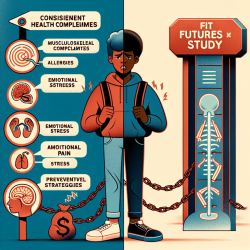Understanding Suicidal Ideation in Adolescents: Insights and Actions
Suicidal ideation among adolescents is a pressing public health concern, particularly in regions with limited mental health resources. A recent study, "Prevalence and associated factors of suicidal ideation among school-going adolescents in Guyana," sheds light on this critical issue. The study highlights the prevalence of suicidal thoughts and the factors associated with them, providing valuable insights for practitioners working with adolescents.
Key Findings from the Study
The study conducted a cross-sectional analysis using data from the Global School-Based Health Survey in Guyana. The findings revealed that 18.4% of adolescents reported having seriously considered suicide in the past 12 months. Notably, the prevalence was higher among females (21.6%) compared to males (14.9%). Several factors were identified as significantly associated with suicidal ideation:
- Gender: Females were more likely to consider suicide than males.
- Bullying: Adolescents who experienced bullying were more than twice as likely to contemplate suicide.
- Depression: A history of depression significantly increased the likelihood of suicidal thoughts.
- Social Support: Having close friends and understanding parents was associated with lower odds of suicidal ideation.
Implementing the Research Outcomes
For practitioners working in schools or with adolescents, these findings offer actionable insights to enhance mental health interventions:
- Gender-Specific Approaches: Tailor interventions to address the higher risk among females. Encourage open discussions about mental health and provide resources specifically targeted at female adolescents.
- Anti-Bullying Programs: Implement comprehensive anti-bullying strategies within schools. Encourage peer support groups and provide training for teachers to identify and address bullying effectively.
- Depression Screening: Regularly screen for depression in adolescents. Early identification and intervention can prevent the escalation of suicidal thoughts.
- Strengthening Social Support: Foster environments that promote strong friendships and family relationships. Encourage parental involvement and educate parents on the importance of understanding and supporting their children.
Encouraging Further Research
While this study provides critical insights, it also highlights the need for further research. Practitioners are encouraged to explore the following areas:
- Longitudinal studies to track changes in suicidal ideation over time and assess the long-term impact of interventions.
- Research on the effectiveness of specific mental health programs tailored to the unique cultural and socio-economic contexts of different regions.
- Studies exploring the role of digital platforms and online therapy in providing accessible mental health support to adolescents.
By integrating these research outcomes into practice and encouraging further investigation, practitioners can play a pivotal role in reducing suicidal ideation among adolescents and fostering healthier, more supportive environments.
To read the original research paper, please follow this link: Prevalence and associated factors of suicidal ideation among school-going adolescents in Guyana: results from a cross sectional study.










